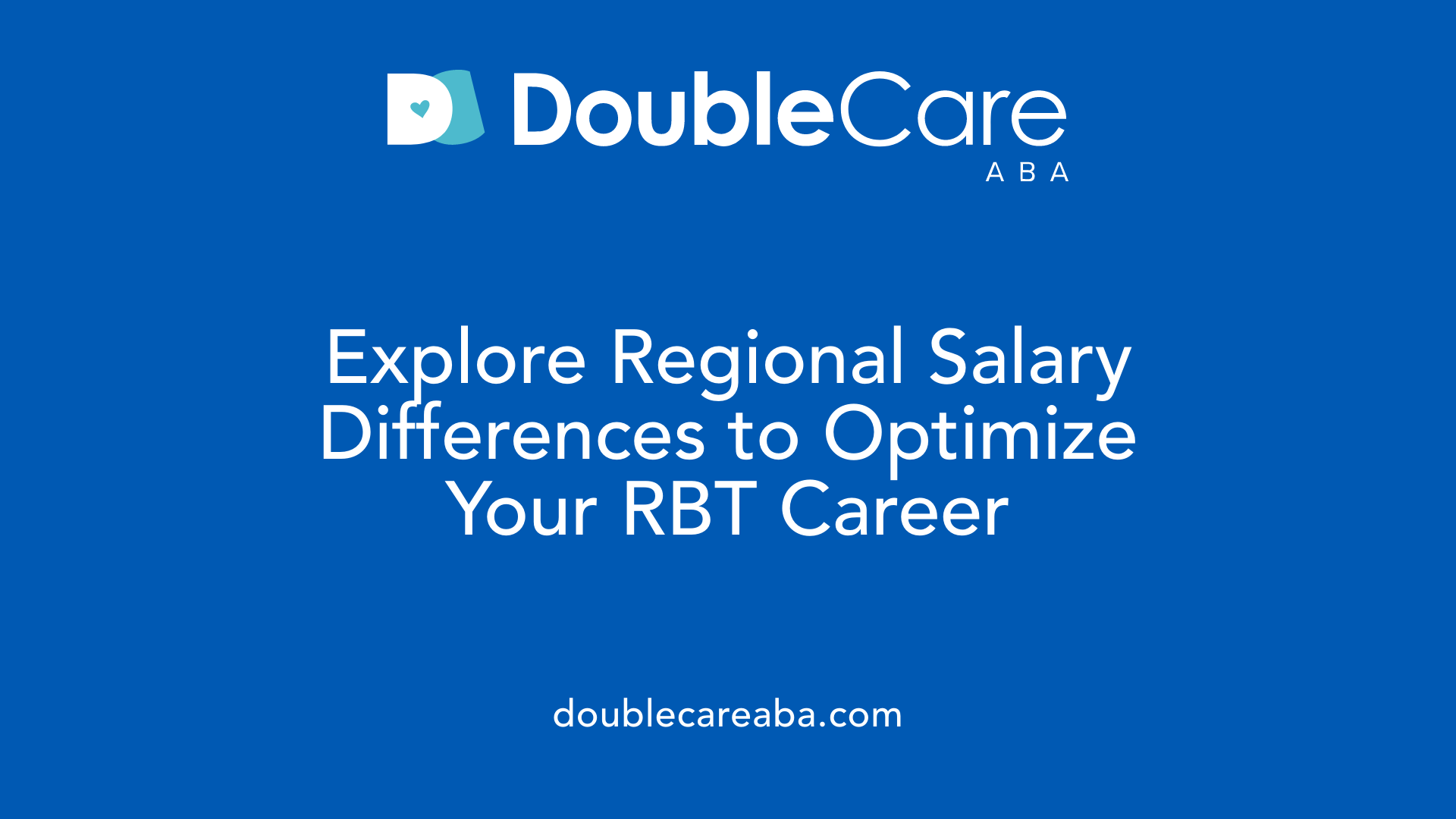Overview of RBT Salaries and Industry Trends
Registered Behavior Technicians (RBTs) play a vital role in delivering behavioral therapy, especially for individuals with autism spectrum disorder. As demand for ABA services grows, so does the importance and earning potential of RBTs. This article explores the average salary, factors influencing earnings, regional variations, industry growth, and ways to enhance income as an RBT.
Current Salary Landscape for RBTs in the U.S.
What is the average salary of a Registered Behavior Technician (RBT)?
The typical salary for a Registered Behavior Technician (RBT) in the United States hovers around $54,000 annually. This figure aligns with median and average salary estimates that range from approximately $43,386 to $56,000 per year, depending on various factors such as location and experience.
Entry-level RBTs generally start earning close to $47,000 per year, providing a solid foundation for those new to the field. Conversely, seasoned RBTs with over ten years of experience can earn more than $66,000 annually, highlighting significant earning potential for experienced professionals.
Salaries for RBTs are not uniform across the country. States like Hawaii lead with the highest average salary at about $54,222 per year. Other high-paying states include California ($47,980), Massachusetts ($46,140), and Connecticut ($45,739). These regional differences are influenced by factors such as cost of living and regional demand for behavioral health services.
Overall, the RBT salary landscape reflects a trend of steady growth, with recent years seeing salary increases driven by expanding industry needs and certification opportunities.
Regional Variations and High-Paying Locations for RBTs

What is the salary range of RBTs across different states?
The salaries of Registered Behavior Technicians (RBTs) can vary considerably depending on the state and local demand. In general, high-cost metropolitan areas tend to offer higher wages to attract qualified professionals. Hawaii stands out with the highest average salary, at about $54,222 annually. This is closely followed by states like California, where RBTs earn approximately $47,980, and Massachusetts with around $46,140 per year.
Other states in the top tier include Connecticut at roughly $45,739 and New York at approximately $44,520. Regional differences are also noticeable in states such as New Hampshire, Vermont, Maryland, and the District of Columbia, where salaries often exceed $40,000, with some reaching nearly $50,000.
Conversely, salaries tend to be slightly lower in less populated or rural regions. However, the overall trend shows that northeastern states generally provide higher wages for RBTs due to increased demand and higher living costs.
| State | Average Salary | Additional Notes |
|---|---|---|
| Hawaii | $54,222 | Highest pay in the U.S. |
| California | $47,980 | One of the top-paying states |
| Massachusetts | $46,140 | High demand for behavioral services |
| Connecticut | $45,739 | Well-paid urban areas |
| New York | $44,520 | Major metropolitan workforce |
| New Hampshire | $39,093 | Higher regional salary average |
| Vermont | $41,975 | Regional pay higher than national average |
| Maryland | $42,515 | Close to urban centers |
| District of Columbia | $40,868 | High demand for healthcare professionals |
How do geographic factors affect RBT salaries?
Regional location plays a crucial role in determining RBT salaries, mainly influenced by demand for behavioral health services, cost of living, and industry presence. States such as New York, California, and Massachusetts command higher wages, driven by their dense populations and higher living expenses.
In contrast, the Midwest and Southern regions often see slightly lower wages, but these differences are offset by lower housing costs and everyday expenses.
Research indicates that RBTs in the Northeast earn about 10% more on average than their counterparts in the Midwest. Urban areas and large metropolitan centers typically offer higher pay, reflecting both the demand for specialized services and the competitive job market.
| Region | Average Salary Difference | Notes |
|---|---|---|
| Northeast | +10% compared to Midwest | Higher demand and living costs |
| Midwest | Baseline | More affordable housing and lower overall expenses |
| South | Slightly lower | Growing demand but lower average wages |
| West | Similar to Northeast | Cost of living influences higher salaries in states like California |
Understanding these regional variations can help RBTs plan their careers and negotiate better pay based on their location and expertise. The industry’s trend toward increasing salaries means that staying updated on regional demand and gaining additional qualifications, such as certifications or advanced degrees, can further boost earning potential.
Evolving Industry and Salary Trends for RBTs
What are the current salary ranges for Registered Behavior Technicians (RBTs)?
The salary landscape for RBTs varies based on experience, location, and education. In the U.S., the average annual salary hovers around $39,520, with a broader industry estimate near $54,000. Entry-level positions typically start at approximately $32,000 to $47,000 annually. Experienced professionals, especially those with 10 or more years, can earn over $66,000 per year. High-cost states or regions offer higher pay; for example, Hawaii leads with an average salary of $54,222, while states like New York and California pay close to or above $48,000.
How does experience influence RBT earnings?
Experience plays a significant role in salary progression. Entry-level RBTs with less than a year of experience earn around $16.21 per hour, translating roughly to $32,000 annually, while those with over 20 years of experience can command hourly rates near $20, equating to $40,000 or more annually. RBTs with 5-10 years of experience generally earn between $45,000 and $55,000, with those beyond a decade surpassing $65,000.
Are there regional differences in RBT salaries?
Yes, regional disparities are notable, with the Northeast generally offering higher wages—about 10% more—than the Midwest. The highest-paying states include New York, New Hampshire, and Vermont, with salaries averaging $48,157, $39,093, and $41,975 respectively. Conversely, some states like Alaska and Maryland have slightly lower averages but still present competitive pay scales.
What are the salary trends over recent years?
The industry has seen a steady increase in RBT salaries. In 2022, the average salary was approximately $38,000, marking a 3.6% rise from the previous year. Over recent years, salaries have moved upward from around $36,000 in 2020 to nearly $45,000–$47,500 now, driven by heightened demand for behavioral services and workforce shortages. This upward trajectory indicates a positive growth pattern that is likely to continue.
What does the future hold for RBT salary growth?
Looking ahead, industry experts forecast ongoing salary improvements. As autism diagnoses increase and insurance coverage for ABA therapy expands, the need for qualified RBTs remains strong. The increasing recognition of behavioral health's importance, coupled with a projected growth in employment opportunities, means that salaries are expected to keep rising.
How can professionals maximize earning potential?
Further education and certifications play a crucial role. Those who pursue becoming a Licensed Behavior Analyst (BCBA) or specialize in faster-growing areas tend to earn more—generally $65,000 or higher for BCBAs. Additionally, taking supervisory roles or specializing in high-demand areas can significantly boost income.
| Experience Level | Typical Salary Range | Average Hourly Rate | Notable Qualifications or Notes |
|---|---|---|---|
| Entry-Level (<1 year) | $32,000–$43,000 | $16.21–$20.00 | Bachelor's or initial certification |
| 5-10 Years Experience | $45,000–$55,000 | $18.00–$20.00 | Advanced experience, certifications |
| 10+ Years Experience | Over $66,000 | $20.00 | Master’s degree, supervisory roles |
This pattern indicates a robust and growing field with promising salary prospects for current and future RBTs. As demand continues to rise, professionals who invest in further education, certifications, and specialization will be well-positioned to benefit from industry growth.
Strategies to Boost Earning Potential as an RBT

How can RBTs increase their earnings?
Registered Behavior Technicians (RBTs) have multiple avenues to enhance their income. One of the most straightforward methods involves gaining more experience. Entry-level RBTs typically start earning around $47,000 per year, but with time and skill development, salaries can climb significantly. RBTs with 5 to 10 years of experience often earn between $45,000 and $55,000, and those with over a decade of practice can make over $66,000 annually.
Pursuing higher education is another effective strategy. For example, earning a bachelor's degree in behavior analysis or a related field can raise starting salaries to between $32,000 and $43,000. Further advancement can be achieved with a master’s degree, especially if combined with certifications such as becoming a Board Certified Behavior Analyst (BCBA). BCBAs typically earn around $65,000 or more, vastly increasing earning potential.
Additionally, obtaining specialized certifications can open doors to supervisory roles and higher-paying positions. Specialized skills in high-demand areas or working in high-cost, competitive markets like California, New York, or Massachusetts tend to offer higher wages. For instance, the highest-paying states include New York, New Hampshire, and Vermont, with average salaries exceeding $48,000 per year.
Finally, diversifying income streams—such as offering consulting, private therapy sessions, or teaching—can further raise earning potential. Staying proactive in professional development, continuously honing skills, and pursuing leadership opportunities are essential strategies for RBTs aiming to maximize their earnings.
Additional Factors Influencing RBT Salaries
| Experience Level | Average Salary Range | Notable Details |
|---|---|---|
| Entry-Level (<1 year) | $32,000 - $43,000 | Start with bachelor's degree, initial certification |
| 5-10 Years of Experience | $45,000 - $55,000 | With experience, salaries increase, more responsibilities |
| More than 10 Years | Over $66,000 | Advanced roles, specialization, higher responsibilities |
| Highest Salary in States | Hawaii ($54,222), NY ($48,157) | regional differences, cost of living impact |
Impact of Education and Certifications on Salaries
| Education Level | Typical Salary Range | Additional Certifications |
|---|---|---|
| Bachelor’s Degree | $32,000 - $43,000 | Basic certification, on-job growth |
| Master’s Degree | $45,500 - $60,000 | BCBA certification, specialized roles |
| Certification - BCBA | $65,000 or higher | Leadership, consulting, private practice |
As industry trends point to increasing salaries and demand for qualified RBTs, investing in education, certifications, and experience remains the most effective way to boost earning potential. By continually upgrading skills and exploring diverse roles, RBTs can navigate career growth successfully and maximize their income.
Summing Up the Compensation Outlook for RBTs
The salary landscape for Registered Behavior Technicians is characterized by steady growth, regional variations, and opportunities for increased earning potential. As the industry continues to expand due to rising autism diagnoses and broader acceptance of ABA therapy, RBT salaries are expected to rise accordingly. By gaining experience, acquiring advanced certifications, and focusing on high-demand locations, RBTs can significantly enhance their earnings. With the ongoing positive trends and industry expansion, a career as an RBT offers promising financial prospects for dedicated professionals.
References
- Average Registered Behavior Technician (RBT) Salary
- Average Registered Behavior Technician (RBT) Salary
- Registered Behavior Technician salary | Autism Resources
- Registered Behavior Technician Salary Guide - PsychologyJobs.com
- Average Registered Behavior Technician (RBT) Salary
- How Much Can You Earn as a Behavior Technician? An Overview
- Registered Behavior Technician Salary in Virginia, United States















